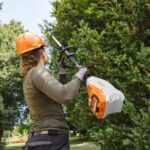
Our 10 Top Hedge Trimming Tips and Advice
There’s something incredibly satisfying about a freshly trimmed hedge. Crisp lines, uniform shape, and that sense of order it brings to a garden — it’s no wonder hedge maintenance is such a crucial part of an outdoor area’s upkeep. But while it might seem like a simple task, good hedge trimming is an art that combines timing, technique, and a keen eye for detail.
Whether you’re shaping box hedges for formality or managing unruly conifers along a boundary, knowing the best hedge trimming tips and techniques makes all the difference. In this guide, we share 10 top shrub trimming tips to keep your garden looking sharp, while promoting healthier, denser growth.
1) Know Your Hedge and Its Needs
 Every hedge variety has its own quirks. Evergreen favourites like box, yew, or holly have different growth habits compared to deciduous hedging like beech or hawthorn. Some demand a precise touch; others tolerate more vigorous pruning. Good hedge trimming advice always starts with sound plant knowledge.
Every hedge variety has its own quirks. Evergreen favourites like box, yew, or holly have different growth habits compared to deciduous hedging like beech or hawthorn. Some demand a precise touch; others tolerate more vigorous pruning. Good hedge trimming advice always starts with sound plant knowledge.
Understanding your hedge’s growth pattern helps determine how often it should be trimmed and when. Fast-growing species may need cutting up to three times a year, whereas others only needs trimming once. Check specific guidance for your variety and you’ll be trimming smarter from the start.
2) Timing Is Everything
 One of our most important hedge cutting tips is to trim at the right time. For hedging requiring twice-yearly trimming, late winter or early spring is typically best for a hard cut, with a lighter trim in summer to maintain shape. Avoid trimming during extreme heat or frost, as both can damage foliage and inhibit regrowth.
One of our most important hedge cutting tips is to trim at the right time. For hedging requiring twice-yearly trimming, late winter or early spring is typically best for a hard cut, with a lighter trim in summer to maintain shape. Avoid trimming during extreme heat or frost, as both can damage foliage and inhibit regrowth.
For flowering hedges, wait until after their blooms fade. And if you’re planning any work between March and August, remember to check for nesting birds — it’s not only ethical but a legal requirement under the Wildlife and Countryside Act 1981.
3) Use the Right Tools — and Keep Them Sharp
 All the top hedge trimming tips mention tool choice. For smaller shrubs or intricate shaping, manual shears give excellent control. But for larger or taller hedges, a petrol-powered trimmer saves time and effort.
All the top hedge trimming tips mention tool choice. For smaller shrubs or intricate shaping, manual shears give excellent control. But for larger or taller hedges, a petrol-powered trimmer saves time and effort.
Long-reach trimmers are ideal for tall hedging, while cordless models offer flexibility and ease of use. Whatever tool you choose, sharp blades are essential. Dull blades tear rather than cut, damaging stems and increasing the risk of disease. Regular maintenance will keep your tools in top form.
4) Prioritise Safety and Comfort
 In terms of safety, even seasoned gardeners benefit from simple tips for trimming shrubs as it avoids complacency. Gloves protect against thorns and allergic reactions (for example from pyracantha and yew), while safety glasses and ear protection are essential when using power tools. Avoid using electric trimmers in wet weather, and always check the ladder is stable if working at height.
In terms of safety, even seasoned gardeners benefit from simple tips for trimming shrubs as it avoids complacency. Gloves protect against thorns and allergic reactions (for example from pyracantha and yew), while safety glasses and ear protection are essential when using power tools. Avoid using electric trimmers in wet weather, and always check the ladder is stable if working at height.
It’s also a good idea to lay out a groundsheet beneath your hedge to catch trimmings. Not only does this speed up the clean-up, but it prevents cuttings from damaging your lawn.
5) Start from the Bottom Up
 When trimming the sides, begin at the bottom and work your way upwards. This approach helps ensure the cut branches fall straight to the ground. Use arcing or sweeping motions with your trimmer, keeping the blades parallel to the hedge.
When trimming the sides, begin at the bottom and work your way upwards. This approach helps ensure the cut branches fall straight to the ground. Use arcing or sweeping motions with your trimmer, keeping the blades parallel to the hedge.
This technique not only delivers a cleaner result but also reduces strain on your body as you work methodically. It’s one of those simple but effective hedge trimming techniques that professionals swear by.
6) Keep It Straight with a Guide
 Struggling to trim straight lines? One of the best tips for trimming hedges straight is to use a taut string line stretched between two canes. Set it just below your desired cut height, and use it as a visual guide as you trim along the top.
Struggling to trim straight lines? One of the best tips for trimming hedges straight is to use a taut string line stretched between two canes. Set it just below your desired cut height, and use it as a visual guide as you trim along the top.
For vertical sides, align your trimming path with a straight lawn edge or kerb. Stepping back regularly to check progress is another basic but essential shrub trimming tip that’s often overlooked.
7) Taper the Shape to Let in Light
 Flat vertical sides may look tidy at first, but they’re not always the healthiest choice for a hedge. One of the smartest tips on trimming hedges is to slightly taper the shape — wider at the base and narrower at the top.
Flat vertical sides may look tidy at first, but they’re not always the healthiest choice for a hedge. One of the smartest tips on trimming hedges is to slightly taper the shape — wider at the base and narrower at the top.
This pyramid-style profile allows sunlight to reach the lower branches, preventing them from becoming sparse or dying back. It’s an especially useful tip for trimming shrubs and taller boundary hedging.
8) Don’t Overdo It – Especially with Conifers
 Some hedges can bounce back from a dramatic cut, but conifers often cannot. Avoid cutting back into old wood — it weakens the hedge and may leave permanent brown patches.
Some hedges can bounce back from a dramatic cut, but conifers often cannot. Avoid cutting back into old wood — it weakens the hedge and may leave permanent brown patches.
Instead, trim little and often during the growing season. Regular, lighter cuts encourage density without risking permanent damage. If a hedge has become overgrown, reshape it gradually over a few seasons rather than trying to fix it all at once.
9) Check for Gaps and Encourage Regrowth
 Got a hedge that’s thinning out in places? A key piece of hedge cutting advice is to encourage regrowth by selectively pruning around the thicker areas to allow more light and air into the gaps.
Got a hedge that’s thinning out in places? A key piece of hedge cutting advice is to encourage regrowth by selectively pruning around the thicker areas to allow more light and air into the gaps.
Sometimes, tying flexible branches into gaps with garden wire or canes can also help fill space over time. You might not see instant results, but with a bit of patience, even patchy hedges can become lush again.
10) Maintain and Feed After Trimming
 The job isn’t over once the trimming’s done. Aftercare is one of the most overlooked hedge trimming tips. Rake or blow clippings off the hedge tops and lawn to prevent smothering. After the winter/ early spring trim, consider mulching around the base with compost or bark to retain moisture and suppress weeds.
The job isn’t over once the trimming’s done. Aftercare is one of the most overlooked hedge trimming tips. Rake or blow clippings off the hedge tops and lawn to prevent smothering. After the winter/ early spring trim, consider mulching around the base with compost or bark to retain moisture and suppress weeds.
For hedges on poor soil or showing signs of nutrient deficiency, a slow-release fertiliser can boost recovery and promote dense growth. A well-fed hedge responds better to trimming, resulting in a healthier, more attractive boundary.
 Ready to Tackle Your Hedge Trimming?
Ready to Tackle Your Hedge Trimming?
At Garden Machinery Direct, we stock a superb range of hedge trimmers from all the leading brands — including long-reach, cordless, electric and petrol-powered models. Pair these tools with our trusted advice and you’ll be perfectly equipped to tackle all kinds of hedge trimming work.




